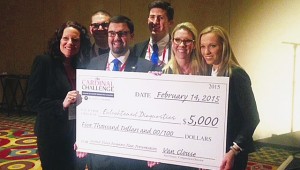
Enlightened Diagnostics™ (EnDx™) from left to right: Gaylene Anderson, advisor; Colin O’Toole, MA ’15; Scott Manwaring, MBA ’15; Chris Cali, MS ’15; Megan Usovsky, MS ’15; and Victoria Zellmer, PhD ’17
A post from our student blogger Megan
When we think about patents we normally don’t think about business. In reality, patents go hand-in-hand with business. Why do people seek patent protection in the first place? Ultimately, patents place a monopoly on a device, machine, manufacture, or method, and insure that others do not make or use the patented item for a specified period of time. Patenting, as you can see, means the difference between having the ability to create a business based around specified items or not.
At Notre Dame I have had the distinct honor of being part of a business team that competes at competitions around the country. This experience has been incredible to say the least. My capstone project for the MSPL has been intricately woven into a business venture. For the past eight months, Chris Cali, ESTEEM masters 2015 candidate; Victoria Zellmer, PhD in biochemistry 2017 candidate; Scott Manwaring, MBA 2015 candidate; Colin O’Toole, Masters of Accounting 2015 candidate, and myself, have met outside school hours to craft a business plan and presentation to sell our inventors’ technology to potential investors. The five of us have learned that building a business from scratch takes a lot of time and effort: sweat equity needs to be poured into creating a business formula that will work, as well as a healthy dose of personal time and attention.
When we first met on a balmy sunny day in August, our business team was all smiles; we had no idea the commitment we were about to engage. With the help of our steadfast business team advisor, Gaylene Anderson, we started to meet at least once every week. The process was slow at first but as we started to decipher the makeup of our technology and how it worked, we were able to begin drafting a rough copy of our business plan over first semester break. The original plan was the culmination of each team member’s contribution: our technology entrepreneur drafted the majority of the business plan, our biochemist added her expertise on the science, our engineer/MBA added his knowledge of the technology as applied to business, the accountant added his numbers throughout spreadsheets, and I added sections devoted to our intellectual property. We entered several competitions ranging from the McCloskey business plan competition here at Notre Dame, to national competitions in Texas and California.
Our first competition took place at the University of Louisville in Kentucky at the Cardinal Challenge on Valentine’s Day. We didn’t know what to expect but we looked dapper in our company color—royal blue—which also paid deference to the University of Notre Dame. With some nerves and a little trepidation, we made it through a fifteen minute presentation. There were four judges that provided feedback after we presented. Some of the feedback was harsh—since we didn’t know what to expect we were thrown off by some of the criticism. We left the first round with some worry that we would not make the final round; however, we also left with a huge sense of accomplishment.
The top four teams were announced during lunch and we were called last. We made it, though! All the hard work had gotten us to at least a spot in the top four. We practiced for another couple hours and then it was show time again. We pitched our idea to a second set of tough judges as well as a larger audience.
I can still remember the feeling I had when the third and fourth runner-ups were announced: complete and utter happiness! Our company name was called for second-place. This was a respectable showing, but the entire team agreed that we were hooked on the spirit of the competition, our technology, and eventually, we set our minds to win it all going forward to other competitions.
Business is integrally tied to patents, and quite possibly to everything we do in life. As the old saying goes, “nothing in life is free.” This means you can capitalize on almost everything out there. But business is more than just making money. It is about selling something that is going to help someone. Our technology is an imaging platform that enhances cancer diagnostics. And I get to be part of this—simply amazing. Now, let’s get down to business, and I’ll update you on our progress as we compete for first place at further business competitions.